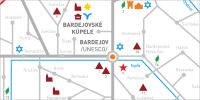     |
The town hall butt Numerous stone sculptures are characteristic of the historical town hall in Bardejov. They go also alongside the renaissance oriel, where you can find the most bizarre one – a little boy with his head between his legs, protruding his naked butt into the square. The boy’s butt faces the house where, allegedly, the mayor used to live. According to a legend, it was a peculiar revenge on the town council for refusing to pay the builders of the town hall even though they had done their work well and on time. As the story goes, one of the builders placed the sculpture near the oriel and thus finished the work under cover of night. On the top of south face of the former town hall, there is a sculpture of Knight Roland holding a halberd, which used to be an old German symbol for town privileges. However, the current sculpture is just a replica of this legendary historical figure that is believed to have lived during the reign of Charles the Great. The original sculpture from 1641 can be found inside the town hall in the museum. It had stood proudly on the top of the town hall until 1737 when fierce wind tore it down. Roland’s oak sculpture is almost two meters tall, sheathed in a copper plate, and draws attention of passers-by to huge holes made by bullets. |
The origin of the damage is unknown to us, though. There has been speculation that Roland, the symbolical protector of the town, used to be the target of enemy armies during some of many sieges Bardejov underwent. In olden times, Bardejov had a reputation for an uncompromising stand against the crime. It was granted the right of sword in 1365. The criminals were often hanged, especially if they committed a property crime (burglary, theft, arson, etc.). Interestingly, decapitation was considered milder and less shameful than hanging. The execution site in Bardejov in the 16th and 17th century was at the so-called Street Lamp Column, which you can still find next to the fortification system, near the Upper Gate. Many years ago, the column was surrounded by a cemetery, but nowadays it belongs to an area of so-called Old Hospital. The Street Lamp Column (or Kopfstock) is one of the oldest architectural monuments of the town. There are several cases of decapitation documented in the town judicial books. An entry from 1573 is quite bizarre, as it reports on a guy called Ján Repka, who was sentenced to death for a theft of a women’s headscarf. Repka was beheaded the same day he committed the crime, under the Street Lamp Column. Such columns were built at cemeteries, memorial sites and crossroads. In the upper part of the column there was a burning fire, which had an orientation and memory function. It also provided the space where heads of the beheaded were displayed. |
The wooden water conduit In 1423, the King Sigismund commissioned the construction of a water conduit which was to supply water into the fortified town and the moat around it. The water pipes were made from trunks of pine trees and connected by iron rings. The water conduit had reached six kilometers throughout the centuries (in year 1925). The fact that the water conduit had functioned for five centuries makes it historically unique. It was the last gravity-fed water conduit with wooden pipes in Europe. It was destroyed as late as 1963. You can find the device for drilling pipes in the Museum of Folk Architecture in Bardejovské Kúpele (Bardejov Spa). John Lennon Street and John Lennon Park in the center of Bardejov are the work of a local devotee and activist – Mr. Pavol Zajac. Zajac’s house walls are decorated with unique 3D graphics as well as metal artworks. The Beatles fans annually commemorate the anniversary of the assassination of John Lennon here. The tradition of the commemorative event takes place on December 8th. The shortest street and the smallest park in the town have their own, specific atmosphere. In the park built from the 1980s, there are stones bearing album titles and names of the band members. The beginnings of this venture caused considerable indignation within The Communist Party. Anyhow, the idea has lasted until today and Bardejov thus has one of the most unique memorials of the Beatles in Central Europe. Translated by: |













